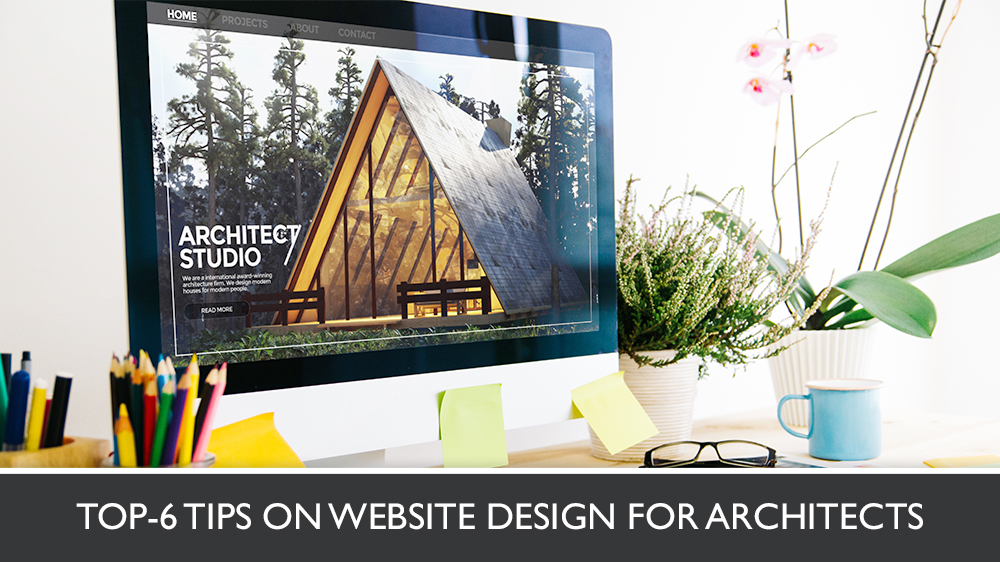Website design for architects is a cornerstone of a firm’s image online. If done wrong, it can turn off visitors once they see the main page. This way, even those who could possibly become your loyal clients will never even get in touch with you. But with flawless website design, you can make your architectural firm stand out, maintain a high reputation, and attract flocks of prospects.
What is the recipe for designing a perfect site for architects? To build a website that will become an asset to your architecture marketing strategy, following these 6 simple tips is more than enough. Read on and check them out!
#1. Make Sure Your Site Has a Simple Navigation
The number one rule for creating a great website design for architects is ensuring easy intuitive navigation. If your site looks like a complicated labyrinth of pages, it will confuse your prospects and they will likely shut it down right after opening. Here are four tips on how to avoid that.
- Provide your website with a noticeable main menu with links to the most important sections. Depending on the design, it can be placed differently, usually in the header or on the sidebar.
- Give sections in the menu clear titles such as About Us, Services, Prices, Portfolio, etc.
- Organize subcategories in the sections in the second-level and third-level dropdown menus. This will ensure your website has a logical structure.
- Embed a search bar in a site. It will allow users to easily find the specific information they are looking for without the need to click through the links.
#2. Keep Your Website Design Clean, Easy to Read, and On-brand
Designing a good website for architects means making it as non-cluttered as possible. To ensure a clean minimalistic look, it is reasonable to do the following:
- Choose a simple color scheme with a maximum of three colors. The main and secondary colors should be more neutral and used for background, while the brightest accent one can highlight the important elements like call-to-action buttons. It’s best to choose specific brand colors and use them not only throughout a website but also in your social media profiles, print collateral, and so on.
- Avoid overwhelming the website with unnecessary elements. Too many pop-ups, links, auto-playing videos, etc. on a page is a visual overload that will frustrate visitors. Website design for architects must be well-balanced: it is ok to use a few catchy visual details but not too many of them.
- Stay away from narrow and too intricate fonts. They are hard to read and viewers quickly get tired of them. As for the size of fonts, it is recommended to use at least 16px for the body text and 1.3-2 times larger size for headings. Smaller fonts are barely readable.
#3. Optimize Your Website for Mobile
Fresh stats show that more than 50% of all website traffic is generated by mobile devices. So, if a site for architects looks poorly and loads slowly on a smartphone, it will probably turn off half of the potential clients. What’s more, mobile-friendly websites rank higher on Google. So, optimizing your site design for mobile is one of the top priorities. Here are the key tips on how to do it.
- Make your website responsive. It means that the arrangement and size of visual elements on a page should adapt to the type of the device and its screen dimensions to ensure the best viewing experience.
- Avoid huge pop-ups. Nobody loves them on desktop, but on mobile, they are especially irritating. It is much easier to leave the website than look for a barely seen X button.
- Compress images. The heavier your pictures are, the longer they will load. It is not recommended to upload images that weigh more than 1 MB. To optimize the imagery for a website for architects without sacrificing quality, you can use special online tools.
- Make buttons large enough to work well on a smartphone. Users feel annoyed when they struggle to click tiny buttons on a small screen.
#4. Add Various Call-to-Action Buttons to Your Website
Any website design for architects should include the classic “Contact Us” or “Get started” button. But it’s much better to have more than that. You can use multiple CTAs offering your prospects something valuable: a free consultation, a comprehensive guide about architects’ services, a news subscription. etc. Those buttons help to build trust with prospects as you provide them with information useful for their business. At the same time, you benefit too, because CTAs allow you to collect your potential clients’ emails. The trick here is to not use too many call-to-action buttons on a page. One or two are usually more than enough.
#5. Use Breathtaking Visuals
The pictures are a centerpiece of website design for architects. All the other elements also matter but play the second role. Your imagery must show your designs at their best, allowing visitors to see your skills, expertise, and style. For this, it is needed to use professional high-resolution photos of your finished projects. If they differ by type, it will be reasonable to divide them into categories — for example, Residential and Commercial.
If you lack images of finished projects, it will be a good idea to opt for architectural 3D visualization. With this service, you can get CG pictures or even a 3D walkthrough animation showing how your currently unfinished projects would look when complete. Or, you can order photorealistic 3D visualization of architectural concepts that exist only in your mind at the moment. This way, you can regularly update your website with the most stunning visuals of your designs.
#6. Add Social Proof
People trust other people’s feedback more than any marketing copy from companies. And it has to be taken into account when designing a website for architects. Your site should not just give the message “Hire me because I`m the best of all architects”. It should provide your potential clients with proof of it. For this, you can empower your site with the following:
- Case studies. Tell the stories of your best designs. Describe your client’s goals and show how your skills helped them achieve those. Showcase your well-thought-out workflow and how it ensures amazing results.
- Clients’ testimonials. Positive feedback from your past customers is the best proof of your credibility. Testimonials can be added to a website in the form of text or video.
- Awards. If your design was awarded at a local, national, or international level, your website should definitely mention it.
All in all, creating a perfect website design for architects is about providing a smooth user experience, showing expertise, and backing it up with positive feedback from clients and industry colleagues. We hope that the above-mentioned tips will help you do that.
Need to enhance your website design with a photorealistic architectural animation of your project? Contact us at CGIFlythrough and get a CG video that will take your potential client’s breath away!









